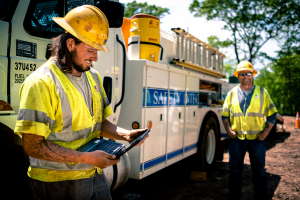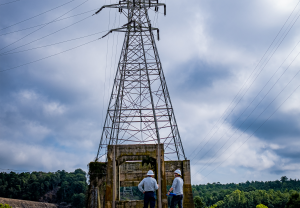WE HAVE 75+ YEARS OF PROJECT EXPERIENCE
Read our case studies to see our solutions at work.
DO YOU HAVE A CHALLENGE TO SOLVE? READ ABOUT OUR PROJECTS TO SEE HOW WE CAN HELP YOU
Read our case studies to see our solutions at work.
Pike Electric offers turnkey solutions covering the engineering, procurement and construction for distribution line upgrades for clients across the U.S. From installing new lines to upgrading or undergrounding existing systems, Pike Electric has decades of experience providing construction, maintenance and restoration services for distribution systems. Our experience and safety record in working with energized lines and equipment are unparalleled.
Our team has successfully upgraded and installed new power distribution equipment and lines for high-rise buildings as part of a public authority’s network equipment replacement program. The program’s goal is to ensure that high-rise buildings in urban centers do not experience power outages that might affect critical services. After a thorough audit, more than 50 locations across the service area were identified to be in need of security and reliability improvements. Our team was contracted for 18 of these upgrade projects.
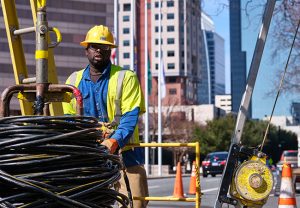
We partnered with a large public utility on an ambitious wood pole replacement project. Our team contributed to all phases of the project, from early planning activities through pole installation.
As we do with every project, our team began with a comprehensive safety and risk review. We brought together our estimating and operations teams to evaluate every aspect of the job for opportunities to maximize scheduling, fleet and crew efficiencies. Our teams planned the logistics, operations and exact service schedule well in advance. Multiple crews were deployed simultaneously across the service areas. Crews fielded poles to determine all pre-construction needs, entering each pole into the established schedule and assigning specific crews. Many poles were replaced while the lines remained energized to limit outages. Including this project, our crews have installed well over 1,500 distribution poles as part of this initiative.
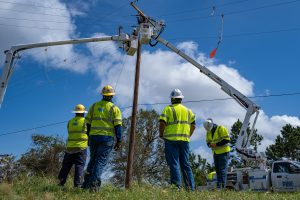
We partnered with a large public utility on a statewide feeder hardening project. The client sought to improve customer reliability and mitigate risks from storms by replacing distribution feeders with larger, more wind-resistant poles and wires. Our team contributed to all phases of the project, from early planning and engineering through the removal of existing structures and installation of new feeders.
The project began with a comprehensive safety and risk review. Once a feeder was scheduled for upgrade, the hardened feeder was designed to meet the utility’s wind-resistance criteria and sent to the utility for approval. We then brought together our engineering and construction teams along with utility representatives to evaluate every aspect of the job for opportunities to maximize scheduling, fleet and crew efficiencies.
Our crews have completely replaced over 1,500 feeders through this initiative. A majority of feeders have been replaced while the lines remained energized to limit outages and work was often completed at night to limit the effect on local businesses.
Commencing in February 2020, we began a complete line rebuild in a Texas metroplex. The project objective was to upgrade substations to a 138 kV double-circuit transmission line using a 2569 A conductor. Additionally, the terminal equipment was upgraded to a minimum rating of 3200 A.
To accommodate this ampacity, the existing conductor was replaced with a new 1926.9 kcmil ACSS/TW/HS “Cumberland” conductor. A portion of line from the primary substation to the secondary substation had a 1926.9 kcmil ACSS/TW/HS conductor with E3X coating installed.
Due to the location of existing structures, Pike installed new structures on existing foundations. The work required the demolition of the existing poles, the demolition of concrete caps to expose anchor bolts, cleaning them and then installing the new structure. This was all completed on the feeder road of a tollway. Traffic control was set up and removed daily to accommodate tollway guidelines.
This switch station, located in a muddy floodplain, offered unique challenges for installing a new 345 kV circuit over an 11-mile course from the switch.
The installation included 18 new Texas V double-circuit lattice steel structures. This line utilized double-circuit 345 kV steel tower structures and bundled two 959.6 kcmil conductors. ACSS/TW/HS “Suwannee” was designed to operate at a maximum temperature of 180 degrees C and 3298 amps. The line was installed with 0.546 in OD 48-count OPGW and 7/16-inch diameter with an EHS steel shield wire.
Given the site’s terrain, this was a unique project with multiple access constraints, including several rivers, major highways and road crossings. To overcome the access constraints, Pike even utilized a helicopter to hoist a truck over a river to install a tower on a stub angle foundation.
Pike recently finished an 11.5-mile, 138 kV line rebuild. The construction was on sandy terrain, which can bring challenges to any construction project. The terrain also had restricted access points, forcing the team to maneuver along a 50-foot-wide right-of-way in an energized corridor.
The project also included the installation of 129 new double-circuit steel pole structures along with three twin-bundle conductor phases. The new line was constructed while the existing 138 kV circuit was energized. To accomplish this, new steel poles were set between the center and leftmost phases of the existing circuit. This strategy required additional effort to modify the existing H-frames to obtain the clearance needed to set new double-circuit steel monopole structures.
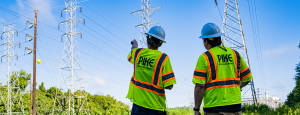
Pike Electric builds and upgrades substations using the latest cutting-edge equipment and construction techniques. Our work is laying the foundation for utility digitization.
A multi-state investor-owned utility turned to Pike to upgrade its substations and protective relays — a major undertaking that Pike completed in two short years. We replaced existing electro-mechanical relays with microprocessor-controlled units, upgraded all distribution substations to be SCADA-capable and installed technologies that enabled remote monitoring and control from a central distribution control center. Through this project, the utility transformed the way it operated and made major strides on its path towards digitization.
This urban center is a magnet for data centers and other businesses that require large amounts of electricity. To address this growing city’s need for electricity, we partnered with the local public authority to construct an important new substation — one of the dozens of urban substations we have built for the client. We brought together a multidisciplinary team to preplan the project and identify challenges and lessons learned from previous substations building projects for the client. This rigorous front-end planning successfully drove the project through installation, testing and commissioning of the new substation.
Substation security includes many challenges, from copper theft, vandalism, industrial sabotage, terrorism and public safety concerns to meeting rigorous North American Electric Reliability Corporation Critical Infrastructure Protection physical security standards (NERC CIP 014). Our industry-leading expertise in utility security is why we’ve consistently been a preferred partner for substation security.
Since 2015, we have teamed with a regional utility to provide security upgrades on 10 substations.
On two recent projects, our team built the infrastructure that enabled perimeter security improvements at the sites. Our work included installing Ameristar security fencing, setting camera poles and conducting the underground construction work needed to support infrared sensors. The underground work included installation of all electrical infrastructure, including fiber optic and power cables, to support cutting-edge perimeter security technology.

We have a track record of completing the most challenging renewable projects while exceeding customer expectations.
Pike led the construction of a 22 megawatt solar plant that spanned over 100 acres with three arrays. A total of 60,000 solar panels were installed across the three arrays. The work included site planning, engineering and construction.
Work began in fall 2019 and there were numerous challenges to overcome, including severe weather, rough terrain, heavily forested portions to clear and delays in solar panel delivery. From autumn 2019 through spring 2020, a mix of snow, pounding rain and heavy winds made portions of the site almost inaccessible. Despite those challenges, the Pike team’s steady management and can-do attitude led to its successful completion.
Pike Electric provided engineering, procurement, construction and testing services for a leading provider of photovoltaic (PV) solar energy solutions, helping it bring four large solar projects online across the U.S. As part of this project we also installed a 34.5 kV collection system and a fiber optic communications backbone from the PV switchgear to the station at each solar site.

Solar Array
Pike was the general contractor for this project and was also responsible for the engineering and design. This project included prepping the site for the equipment, designing the footings, battery and inverter installation, testing, permitting and assistance with other on-site duties.
When a large investor-owned utility needed energy storage solutions for a solar facility, Pike Electric answered the call. Our support included procurement, field assembly, installation, testing, protocol development and commissioning. In the end, we installed eight separate storage units at the site, totaling ___ MWh.
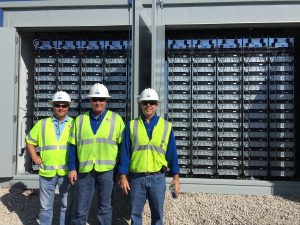
Pike Electric deployed crews for overhead distribution, underground distribution and transmission restoration work. We essentially rebuilt the electrical infrastructure of Lake Charles, Louisiana, which was the epicenter of damage. At the restoration’s height, we had the largest number of linemen on the job — a workforce about three times larger than the next largest contractor.
Pike remained on the move throughout the Isaias response. The storm was originally predicted to make landfall on the northeast coast of Florida, before shifting to instead make landfall in the Carolinas. The storm then swept north, causing widespread outages in the densely populated Northeast, including metro New York City. Pike employees continued to deploy and redeploy further north as the storm progressed. The majority of our response efforts took place in New Jersey, Delaware, New York and Connecticut. Some crews traveled from as far away as Texas to respond.
